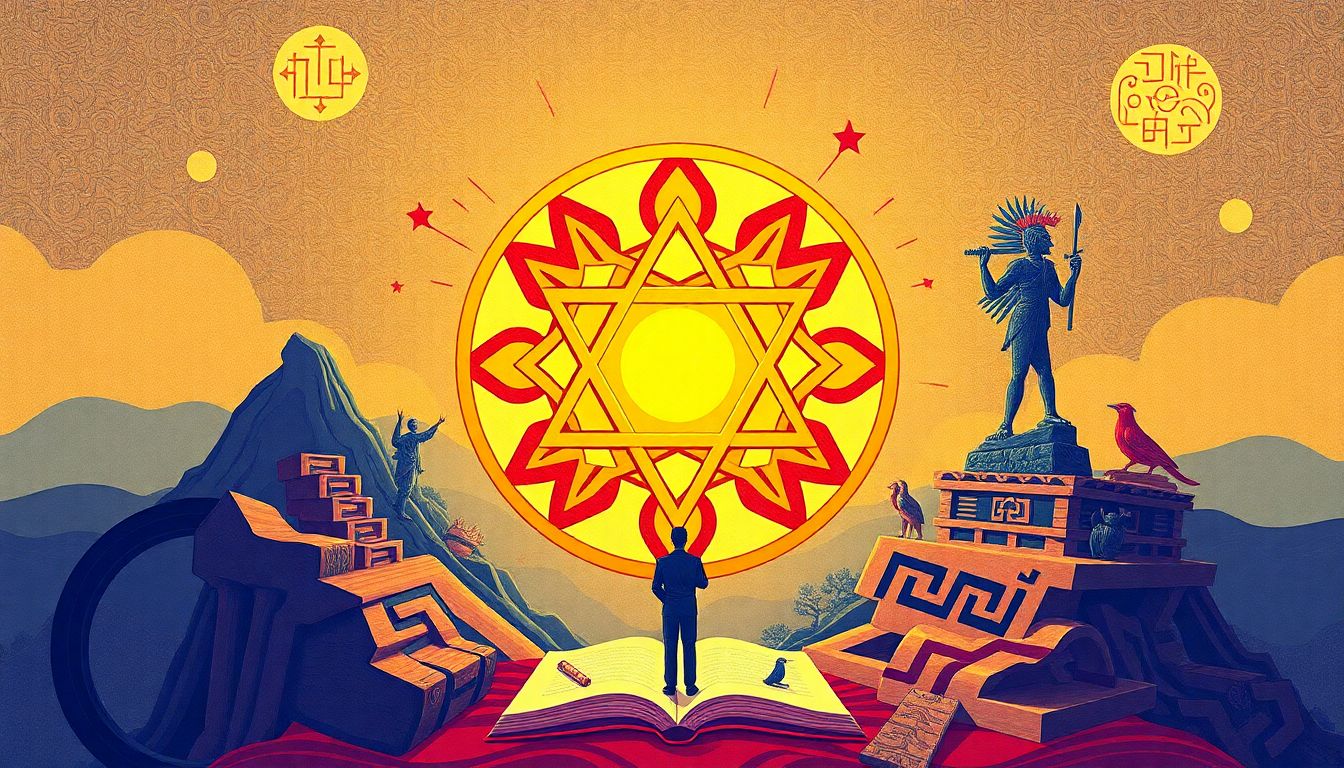Unlocking the Mysteries: Hexagram Symbolism Across Cultures and Philosophies

Unlocking the Mysteries: Hexagram Symbolism Across Cultures and Philosophies
The hexagram, with its captivating six-pointed star shape, holds a wealth of meaning across various cultures and philosophies. This powerful symbol transcends borders, appearing in ancient texts, religious contexts, and modern art. Its diverse interpretations reveal the fascinating ways societies have connected with this emblem of unity and duality.
The Hexagram's Global Reach: A Brief Overview
The hexagram is often recognized as a universal symbol that spans different cultures. From Eastern traditions, like the I Ching, to Western religions, such as Judaism, the hexagram has found its place in people's lives. Each culture employs this shape to convey profound concepts, making the hexagram a vital aspect of human expression.
Beyond the Six-Pointed Star: Diverse Interpretations and Uses
The uses of hexagrams are as varied as the cultures that embrace them. They serve different purposes, such as:
- Mystical Tools: Used in divination and esoteric practices.
- Cultural Symbols: Representing values and beliefs.
- Artistic Inspirations: Seen in visual art and design.
Exploring the Article's Scope: A Journey Through Time and Cultures
This article will explore the hexagram's significance across multiple contexts. We will traverse through ancient China, Judaism, Western esotericism, pagan and Wiccan traditions, as well as its influence in art and design.
Hexagrams in Ancient China: The I Ching and its Influence
The I Ching: Divination and Self-Discovery Through Hexagrams
In ancient China, the I Ching, or Book of Changes, uses hexagrams as tools for divination. This classic text consists of 64 hexagrams, each representing a unique situation or life challenge. The process of casting these hexagrams allows individuals to reflect on their circumstances and seek guidance.
Interpreting Hexagram Meanings: A Complex System of Symbolism
Each hexagram in the I Ching has intricate meanings. These meanings emerge from the combination of broken and unbroken lines, indicating yin and yang energies. The interpretation often involves a fusion of philosophical insights and personal reflection.
Case Study: The Use of Hexagrams in Traditional Chinese Medicine
In traditional Chinese medicine, hexagrams link to balancing energies within the body. Practitioners may utilize the I Ching's wisdom to align healing practices with the patient's unique condition. This correlation illustrates the hexagram's role in mental and physical well-being.
Hexagrams in Judaism: The Star of David and its Significance
The Star of David: History and Symbolism
The hexagram is widely recognized as the Star of David, a symbol of Jewish identity. Its origins trace back to ancient Jewish texts, signifying divine protection and connection to God. This two-dimensional representation embodies the intertwining of the spiritual and material realms.
The Star of David in Modern Judaism: Continued Relevance and Adaptation
Today, the Star of David remains a potent symbol in Judaism, often seen on synagogues and the Israeli flag. Its adaptation in modern society emphasizes community and faith, bridging the past and present for Jewish people worldwide.
The Star of David in Popular Culture: Representations and Misinterpretations
In popular culture, the hexagram is sometimes misinterpreted or commercialized. While it can evoke strong emotions and connections, misconceptions persist. Understanding its historical significance helps clarify the symbol’s true meaning.
Hexagrams in Western Esotericism: From Alchemy to Modern Occultism
Hexagrams in Hermetic Traditions: Symbolic Correspondences
Western esoteric traditions frequently draw upon hexagrams, particularly in Hermetic practices. They symbolize the connection between the microcosm and macrocosm, representing mankind and the universe. This interplay highlights the search for knowledge and enlightenment.
Hexagrams and Astrology: Connections and Interpretations
Astrologically, hexagrams can represent celestial influences and life cycles. Their patterns often correspond to planetary movements, providing insights into individual experiences and relationships.
Modern Esoteric Uses: Hexagrams in Tarot and Other Divinatory Systems
Hexagrams have found their way into modern tarot and other divinatory practices. They serve as guides to understanding one's path and making sense of life’s challenges, showcasing their enduring relevance in spiritual exploration.
Hexagrams in Pagan and Wiccan Traditions: Nature and Spirituality
Hexagrams as Representations of Natural Elements
In pagan and Wiccan traditions, hexagrams symbolize elemental forces. They can represent air, fire, earth, and water—crucial aspects of nature. This connection evokes a sense of harmony and balance with the natural world.
Hexagrams in Ritual and Ceremony
Hexagrams are often part of rituals and ceremonies, representing unity among the elements. They foster a powerful atmosphere during spiritual gatherings, guiding intentions and enhancing communal experiences.
Modern Interpretations: Hexagrams and Personal Growth
Contemporary practitioners interpret hexagrams as symbols of personal growth and transformation. By tapping into their energy, individuals can cultivate self-awareness and empowerment.
Hexagrams in Art and Design: Aesthetic and Symbolic Applications
Hexagrams in Architecture and Visual Art
Architecture and visual art frequently incorporate hexagram designs. These structures and works convey a dynamic beauty, symbolizing unity and balance. Artists employ hexagrams to evoke deeper meanings tied to the human experience.
Hexagrams in Fashion and Popular Culture
Fashion often adapts hexagram motifs, appealing to cultural significance and aesthetic appeal. From clothing to accessories, the hexagram serves as a symbol of individuality and creativity, bridging style and meaning.
The Enduring Appeal of the Hexagram: A Timeless Design
The hexagram's striking visual nature ensures its enduring popularity. Whether in ancient texts, religious symbols, or modern art, its appeal remains timeless, resonating with diverse audiences.
Conclusion: The Timeless Appeal of the Hexagram
Key Takeaways: A Synthesis of Hexagram Symbolism
The hexagram has rich meanings across cultures and philosophies. Its uses in divination, identity, and art highlight its importance in human expression.
Further Exploration: Resources and Continued Learning
To dive deeper into the hexagram's significance, explore resources like the I Ching, Jewish texts, and modern esoteric literature. Engaging with these materials can provide further insight into its multifaceted nature.
Actionable Tip: Engage in Mindful Reflection on the Symbolism of the Hexagram
Consider reflecting on how the hexagram resonates with you personally. Look for ways to incorporate its symbolism into your life, creating a deeper connection with this powerful emblem.
%20(2).png)
















Comments